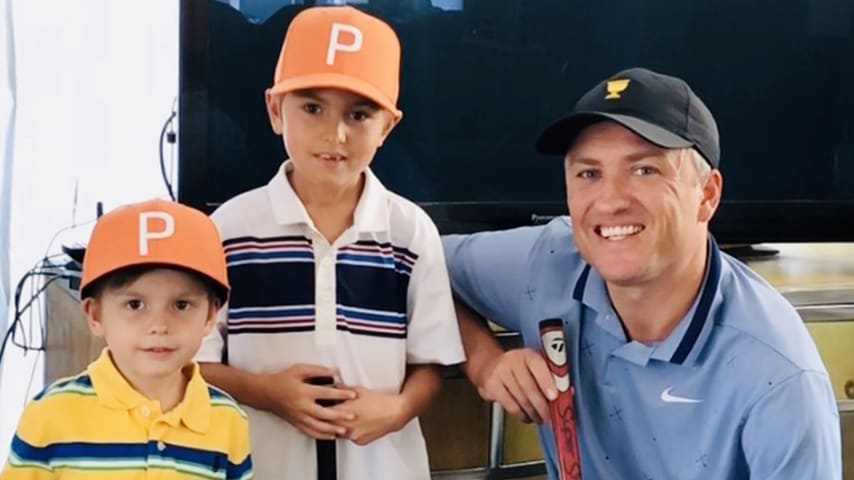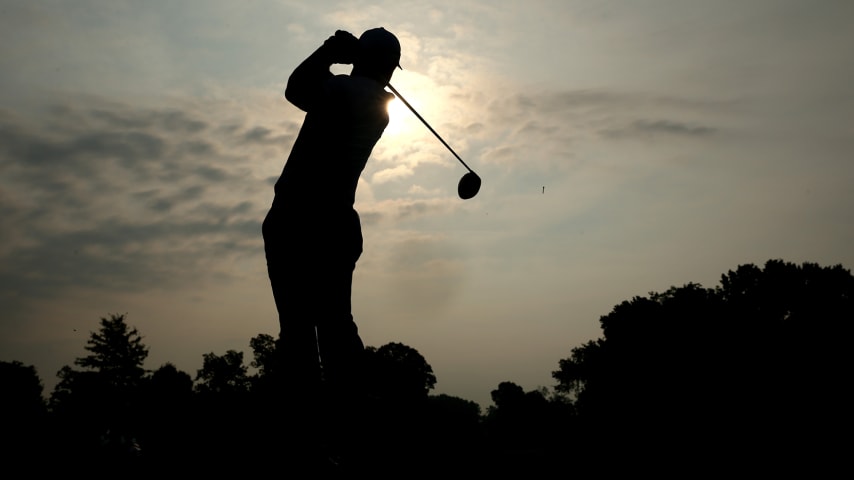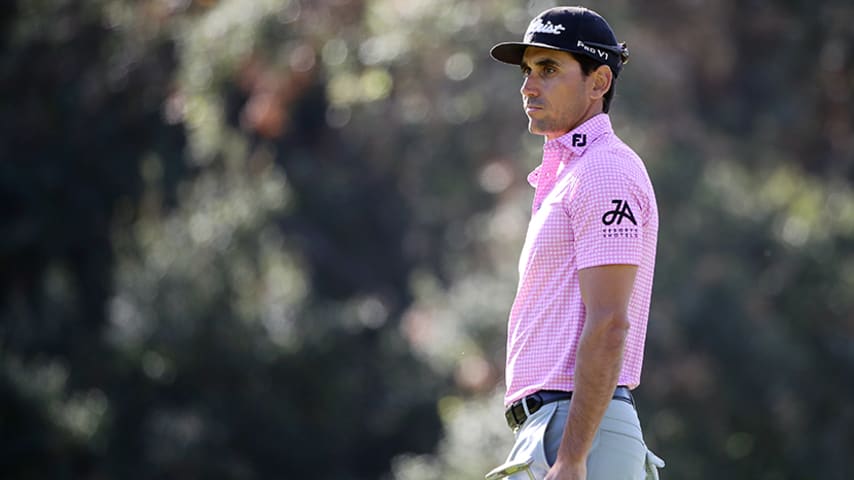Golf as a lesson plan
13 Min Read

Young kids at home and you’re their teacher now? Not to worry. Golf can organize their studies.
Young kids at home and you’re their teacher now? Not to worry. Golf can organize their studies.
Writer’s note: These are challenging times for us all, and school closures around the globe due to COVID-19 have made things especially difficult for parents and their school-age children. As a father of two young boys, I immediately knew outside-the-box thinking was needed to keep them engaged AND keep their educational journey on track.
So I decided to use golf, a passion of mine and theirs, to help the cause. Below is the story I wrote, after the first week of stay-at-home measures in California, of the initial journey my family took in our quest.
Now we know that from little things, big things grow. The response from the PGA TOUR and wider golf community was overwhelmingly positive. In partnership with First Tee, we decided to take things to another level by providing PGA TOUR fans and their families a place to access free interactive, educational and golf-themed activities and resources that we hope will be both fun and instructive for youngsters.
PGA TOUR Links to Learning is that place. Please enjoy the introductory phase as we continue to build out our curriculum and harness the power of our incredibly talented PGA TOUR players and their families. I hope it helps golf become part of the journey for you and your children as they further their educational and emotional development.
LOS ANGELES -- As if the anxiety of a global pandemic wasn’t enough for parents around the world, an additional scary reality for some of us would soon set in. Working from home is one thing; adding an extra full-time job as a schoolteacher is another.
As the PGA TOUR, NBA, NHL and other sports started to shut down, so too did schools across the nation. For me, that meant juggling my writing commitments with becoming a first grade and preschool teacher for my two sons -- Ashton, 7, and Hudson, 4.
For the first few days, this appeared even more daunting as my wife Janelle was still needed at her office, but as the coronavirus situation escalated in California, she joined me in this at-home juggle. It is one we will be tackling together for the foreseeable future after Gov. Gavin Newsom ordered a statewide stay-at-home mandate.
Being responsible for keeping children on a solid academic path in these times is something we all hope to achieve, but is also a bit unsettling. We are not trained teachers – and yes, it gives a whole new appreciation for the heroes that they are. The added dimension of being mindful of each child’s mental health, and that of our own, also looms large.
So it got me thinking. I have always been one who does better when working inside the confines of things I am passionate about. It is why I work for the PGA TOUR. I love golf. And it turns out, even at a young age, my boys love it too.
How can I harness this in my new role as primary educator? Easy! Golf can be applied to just about any school subject. This also is true of other sports, so if you love golf but your child is a soccer fan, you can likely adjust. Football, basketball, baseball … or even the newly popular marble racing. With a little thought, you can make learning tailored to your sport-loving child.
Regular teachers must juggle 20 or more kids with differing passions, but here you get the benefit of focusing in on no one but your own. Of course, former PLAYERS champion Webb Simpson and his wife Dowd with their tribe of six kids might find it a little more challenging … but you get the idea.
Over the past few days, I have put my ideas into practice with my first grader Ashton and Hudson, a preschooler. So far, the results have been encouraging, so I’ll provide a few examples of this method. Hope it helps, even if it’s just the seed for your own ideas.
Mathematics
There is a great old commercial with a younger Ernie Els in a classroom full of kids.
He scribbles on the chalkboard. “What does 4 + 4 + 3 + 4 + 5 +2 + 4 + 3 equal?” he asks. Most kids are puzzled but one little girl shoots her hand in the air.
Ernie calls on her. “Sarah.”
“3-under-par,” she says proudly.
It is a clever play on the fact that golf is full of math. My lessons with my boys revolve around the basic numbers. First, we learned about how most holes are par 3s, par 4s or par 5s and what that means. Albatross, eagle, birdie and bogey were all explained with their value to par. We also talked about how there are 18 or 9 holes on most courses. Their young age meant we didn’t need to go very deep.
If Tiger Woods took three strokes on the first hole, four on the second hole and two on the third hole how many has he had in total so far? If the first hole was a par 4, what did Tiger make there? And his score in relation to par?
For Ashton, we went a little further. I dug up scorecards from PGA TOUR players who were the focus of our “speed rounds” over the last year or so. These are highlight compilations from PGA TOUR LIVE showing each shot from a specific player. Check them out here or on GolfTV if you live outside the USA.
I asked him to calculate the player’s front-nine and back-nine totals and show his work. Then get the total for the round. How was it in relation to par? We then broke down par-3, par-4 and par-5 scoring to see if there was something that stood out and discussed why that might be. For fun, I would then show him a hole or two from the speed rounds so he could see the numbers in action.
The possibilities with math are endless. If you have older kids, you can work out averages. Look at distance. Or go right down the rabbit hole of our enormous stats library, including the Strokes Gained metrics. Here’s a great video from PGA TOUR winner Mark Wilson explaining some of that.
Geography
Golf is a global sport. And so creating a simple geography lesson for the youngsters was not difficult at all. I printed out two maps. One of the world, another of the USA. From there, I printed out the headshots from the 24 players who competed in the recent Presidents Cup, adding their home country (for the International Team) or home state (for the United States Team).
The boys simply needed to find where they were from and match them up to the maps. We then spoke about those states and countries briefly, thinking about things they are known for. For older kids, you can just expand the search and expand the learning about different places in the world.
History
Where was golf invented? Who are the greatest players, both male and female? What is the PGA TOUR exactly and how did it begin? These were the questions I posed to my sons. With the help of a few Google searches (sadly, the old-fashioned library is not open right now), they came up with some answers. Given their age, we bypassed the debate of ancient games and started in Scotland for our golf history. We expanded into some research on the Open Championship plus Old and Young Tom Morris. This sparked up Ashton’s memory. “I have a book on him, don’t I, Dad?”
He does indeed have one on Young Tom – a storybook I nabbed from St. Andrews during the 2015 Open Championship called “Little Tommy Morris” by Roger McStravick. It tells the tale of young Tom with a fun focus on visualization.
We moved on to all-time greats, but trying to describe the Tiger vs. Jack debate to a 7-year-old proved somewhat tricky, so we pivoted again to the great women of the past. Given my Australian background, there might have been a slight bias toward Karrie Webb.
After we learned about the origins of the PGA TOUR, both boys seemed to have a greater appreciation for what their father actually does – even if the younger still thinks I play golf when I go on the road rather than write and talk about it. I’m not looking forward to the day they realize how poor my playing skills actually are.
Reading
Reading has become an undervalued and underutilized skill in modern day society. But just ask FedExCup champion Rory McIlroy how important it can be.
While Ashton reacquainted himself with Little Tommy Morris, Hudson and I read “The ABC’s of Golf” and “Swing into Opposites with Golf” by Susan Greene. These kids’ books were picked up during the PGA Championship in 2015 at Whistling Straights and personally signed by the author. There are hundreds of reading options when it comes to golf you could use – including, of course, PGATOUR.COM. But I’m not sure how I should take the fact that Ashton didn’t last long going through his old man’s stories.
Writing
After letting me know my stories were “a bit too boring” for him, I challenged my eldest son to write his own golf story. Again the premise was simple as I just gave him the title: Why I like golf. Any of my annoyance from his critique of my writing drained away pretty fast when one of his main reasons was, “I get to play it with my Dad.”
Art
This one was simple. Some paper, crayons, markers and a simple instruction. If you were designing a golf hole, what would it look like? It was fun to watch their little minds work, adding water and sand. Designing first straight, then trying to add doglegs. Ashton thought a snake-like hole would be cool. Hudson liked having a big lake to play over -- albeit with a “fairway” bridge you could hit onto “if you can’t hit it very far like me yet.”
His next question took us to the next lesson.
“Dad, can we actually build our own golf hole?”
Engineering
OK, so the boys couldn’t build a real golf hole at home – I don’t exactly have a Tiger Woods-size backyard -- but they could design a mini-golf hole. In fact, they came up with three. First, they utilized my putting mat with ball return. They lined the edges of the 7-foot mat with soft blocks for walls and added a bridge from their magic tracks car set right in the middle. If you went over the bridge, you could make an ace … but if you went around it, you most likely were looking at a two.
The second hole was made from spare felt that comes out when Dad hosts poker nights, and they created a tunnel through their arched blocks. The same premise applied. Take the risk of going through the tunnel and a hole-in-one might result, but misjudge it and perhaps face a big number.
Lastly they pulled out their own putting mat – a version that has three holes to aim at. This is where they really added some creative flair. Using their extensive Hot Wheels collection, they created pathways to the three holes. One was easy, one medium, one hard. When I asked Ashton why anyone would bother going for the hard hole, he shot me one of those looks kids are famous for, the type that is silent but means, “What are you, some kind of idiot?”
Turns out he hadn’t finished the design yet. He and his brother cut out circles of paper the size of the holes and wrote -1, -2 and -3 on them before placing them in the easy, medium and hard options respectively. “The last hole at mini golf is always different. Whichever hole you go in, you get to take that off your score,” he explained.
After a few practice rounds, we took on the par-6 course. Dad took no prisoners, shooting +1 but with a -2 bonus, leaving me with a 5-shot total. Ashton shot +4 off the stick but did get the -3 bonus for a 7 total, while young Hudson was also +1 off the stick, with the only ace of the match coming via the -1 bonus for a 6-shot total. I guess I’m not one of those let-your-kids-win dads … at least not yet.
Physical Education
While we could have just hit wiffle and sponge balls outside on the front yard for our exercise – and we have a few times – we took it up a notch with a fun circuit course. Sort of a drive, chip and putt competition but with a speed component.
First, a sprint from a start line to a club where you had to hit chips until you hit a ball into the target net. Then run to the second station, where you took driver and needed to get the wiffle ball past a certain distance, but also between the accuracy lines. Then, a quick bolt to the 5-foot putt. Make that and run to the finish to stop the clock. We didn’t try to beat each other, just our own personal best times.
Future Lessons
This is all we have managed to get through in our isolation, but there are further plans to add a few scienceexperiments around why putts break certain ways and why a regular golf ball rolls differently to a wiffle ball and a sponge ball.
So far, I have resisted showing those videos to my sons, as they were lucky enough to recently meet Rickie Fowler and he’s a favorite for them. On second thought, maybe this is how I get them back toward Aussies stars Adam Scott, Marc Leishman, Jason Day and Cameron Smith.
With so much uncertainty when schools will re-open, I may need to fall back on screen time to fill some of the void. Never fear – I’m sure they can sit and watch replays of a few final rounds from this season. I’ll probably start with the Sony Open in Hawaii, Farmers Insurance Open and The Genesis Invitational.
If you’re wondering why, just check out the winners. I’ll supply the map if necessary.
RESOURCES
Tiger Woods and his TGR Foundation in partnership with Discovery Education have created TGR EDU: Explore - a no-cost digital platform for educators and students. This gives free access to TGR Foundation’s award-winning STEM curricula, college-access programs and career development. The website offers interactive digital resources, designed for students in grades 6-12, which develops problem-solving and decision-making skills with real-world applications in college-access and STEM learning. TGR EDU: Explore offers 40-plus assets for educators, students and families including webinars, lesson plans, family discussions starter and a Virtual Field Trip to Facebook.
Links to Learning the PGA TOUR's free, online educational resource hub in partnership with First Tee. Check out the individual subjects here:
• Art
• English
• Health
• History
• STEM






